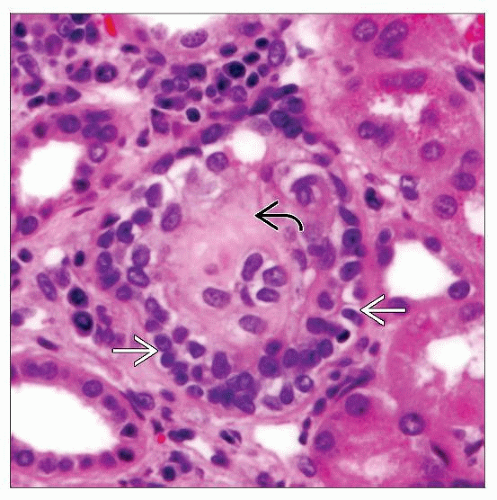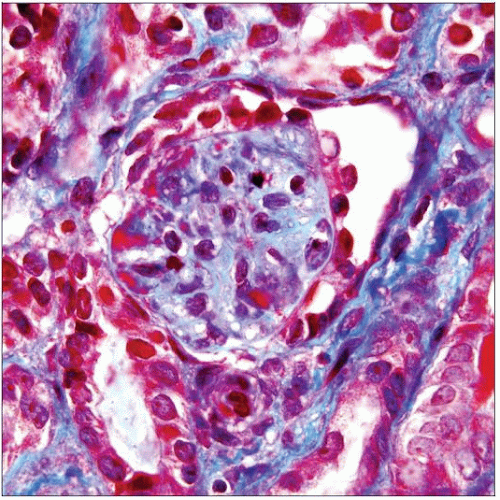Diffuse Mesangial Sclerosis
Helen Liapis, MD
Joseph Gaut, MD, PhD
Key Facts
Terminology
Diffuse mesangial sclerosis
Etiology/Pathogenesis
WT1 mutations (Denys-Drash or Frasier syndromes)
Laminin β2 mutations (Pierson syndrome)
Idiopathic
Clinical Issues
Progression to ESRD in 3 years
Presents early in life, usually under 2 years of age
Slower progression to ESRD if no mutation is identified
Microscopic Pathology
Early glomerular changes resemble fetal glomeruli
Late glomerular changes consist of replacement of mesangium by fibrillar matrix and mesangial consolidation
Pseudocrescents
Tubules dilated with hyaline casts
Ancillary Tests
Gene sequencing of WT1, PLCE1, and LAMB2 genes
Karyotyping to rule out male pseudohermaphroditism (Frasier syndrome)
Top Differential Diagnoses
Denys-Drash syndrome
Frasier syndrome
Pierson syndrome
TERMINOLOGY
Abbreviations
Diffuse mesangial sclerosis (DMS)
Definitions
Glomerular disease early in life with characteristic mesangial accumulation of extracellular matrix and podocyte proliferation
Although most cases are idiopathic, a subset are caused by a variety of genetic and other factors
ETIOLOGY/PATHOGENESIS
Genetic Factors
WT1
Encodes Wilms tumor-1
Zinc finger transcription factor involved in regulating cellular proliferation and gonad and podocyte differentiation
Maps to chromosome 11p13
Mutations in exons 8 and 9 are occasionally associated with sporadic DMS
Exon 9 mutations typical of Denys-Drash syndrome
Hotspot in exon 9 R394W/Q/L
Intron 9 mutations typical of Frasier syndrome
PLCE-1
Encodes phospholipase C enzyme (PLC∈1) on chromosome 10q
Truncating mutations are associated with DMS
Nontruncating missense mutations are associated with FSGS
Inherited in autosomal recessive pattern
Gallaway-Mowat syndrome
Type 1 carbohydrate-deficient glycoprotein syndrome
Laminin-β2 mutations (Pierson syndrome)
Infectious Agents
Cytomegalovirus
DMS associated with cytomegalic inclusion bodies described in newborn with congenital nephrotic syndrome
CLINICAL ISSUES
Presentation
Nephrotic syndrome
Steroid resistant
< 2 years of age but may be as late as 4 years
Laboratory Tests
α-fetoprotein may be elevated
Stay updated, free articles. Join our Telegram channel

Full access? Get Clinical Tree






